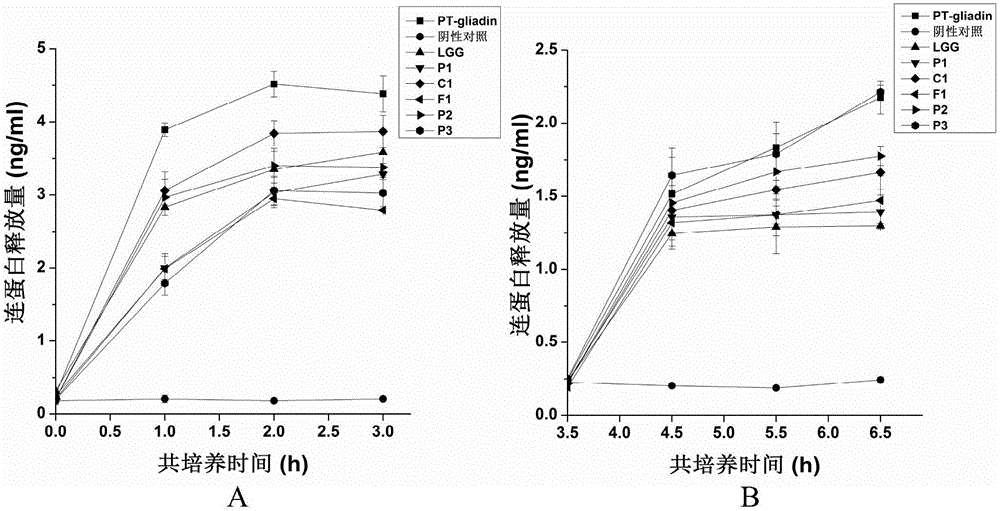Method for screening probiotics with function of enhancing intestinal cell tight junction at cell level
An intestinal cell, cell-level technology, applied in microorganism-based methods, biochemical equipment and methods, bacteria, etc., can solve problems such as the inability to accurately reflect the function of probiotics in regulating the intestinal barrier
- Summary
- Abstract
- Description
- Claims
- Application Information
AI Technical Summary
Problems solved by technology
Method used
Image
Examples
Embodiment 1
[0075] Example 1: Comparison of Different Cell Treatment Methods
[0076] At first the subsection incubation method provided by the invention is compared with the traditional co-incubation method, as figure 1 As shown, A in the figure means adding RPMI 1640 cell culture medium without serum and antibiotics and incubating with HT-29 cells for 3 hours before washing off; B means adding PT to RPMI 1640 cell culture medium without serum and antibiotics -gliadin was washed away after co-incubating with HT-29 cells for 3 hours; C indicated that PT-BSA was added to RPMI 1640 cell culture medium without serum and antibiotics and washed away after co-incubating with HT-29 cells for 3 hours; D indicated that the PT-gliadin was added to the RPMI 1640 cell culture medium without serum and antibiotics, and at the same time, different kinds of probiotics were added to incubate with HT-29 cells for 3 hours, and then washed away; E indicated that PT-gliadin was used without serum and antibiot...
Embodiment 2
[0084] Example 2: Comparison of tight junction protein expression levels obtained in different cell treatments with tight junction protein levels in animal experiments
[0085] (1) Changes in the relative expression of tight junction-related protein genes in cells:
[0086] ①Use the total RNA extraction reagent TRIzol (Invitrogen, Carlsbad, CA) to extract total RNA from HT-29 cells according to the manual;
[0087] ②Use Prime Script, a reverse transcription kit containing gDNA clearance TM RT reagent Kit (Takara, Tokyo, Japan), reverse transcribed RNA into cDNA according to the manual;
[0088] ③The samples were mixed with fluorescent dye SYBR Green super mix (Qiagen, Germany), and the real-time fluorescent quantitative gene amplification instrument CFX96 TM Real-Time System (Bio-Rad, Hercules, CA) was used for detection. Three parallel wells were set up for each sample, and the housekeeping gene β-Actin was used as a reference. The results were analyzed by the 2-ΔΔCq meth...
Embodiment 3
[0097] Example 3: Effects of different treatment methods on the transmembrane resistance values of different intestinal epithelial cells
[0098] Spread HT-29 cells in a permeable nested chamber (3640-Clear, Corining Corporate), add 400 μL of RPMI 1640 cell culture medium without serum and antibiotics to the inner chamber and add 1 mL of serum and antibiotics to the outer chamber The RPMI 1640 cell culture medium was cultured until the monolayer of cells covered the entire membrane surface. After washing away the culture solution, add 4mg / mL PT-gliadin and 1×10 8 CFU / mL of RPMI 1640 cell culture solution without serum and antibiotics 400 μL of probiotics, 1 mL of RPMI 1640 cell culture solution without serum and antibiotics was added to the outer chamber to continue culturing for 3 hours; Incubate the cells with 400 μL of RPMI 1640 cell culture medium without serum and antibiotics containing 4 mg / mL PT-gliadin for 3 hours, then wash the cells in the chamber with phosphate b...
PUM
 Login to View More
Login to View More Abstract
Description
Claims
Application Information
 Login to View More
Login to View More - R&D
- Intellectual Property
- Life Sciences
- Materials
- Tech Scout
- Unparalleled Data Quality
- Higher Quality Content
- 60% Fewer Hallucinations
Browse by: Latest US Patents, China's latest patents, Technical Efficacy Thesaurus, Application Domain, Technology Topic, Popular Technical Reports.
© 2025 PatSnap. All rights reserved.Legal|Privacy policy|Modern Slavery Act Transparency Statement|Sitemap|About US| Contact US: help@patsnap.com



